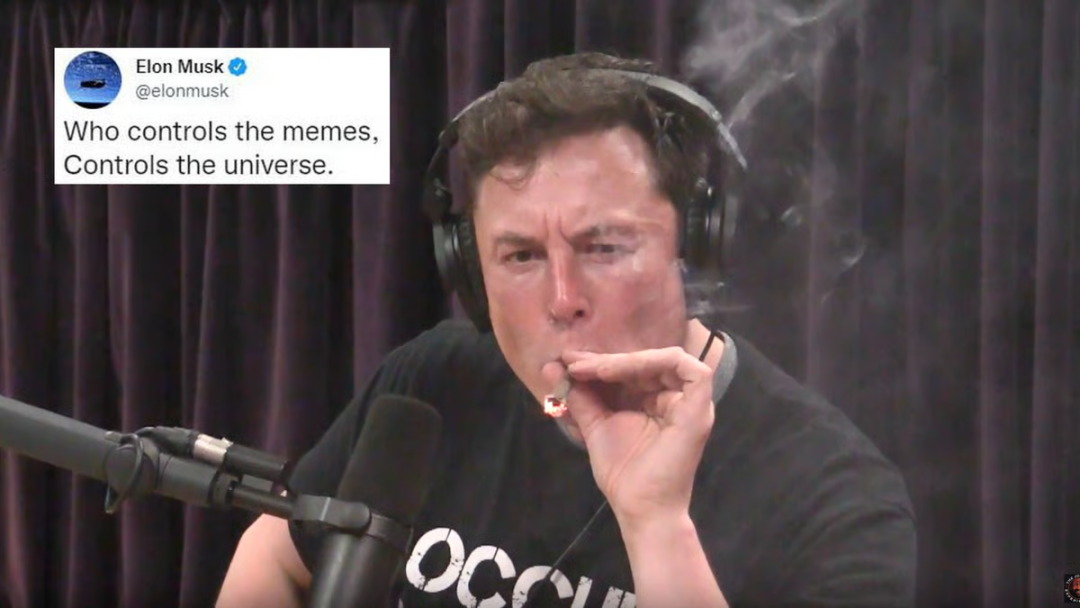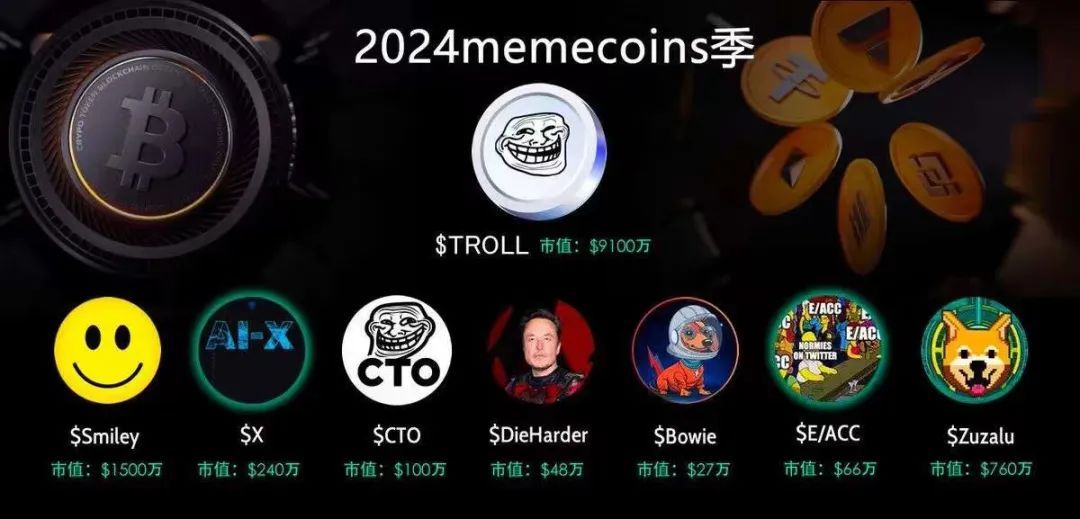Who controls meme, controls the universe
Author: Day | Plain-language Blockchain / Source

Recently, with the assistance of Musk's tweets, meme assets such as Troll and Zuzalu have surged in popularity. So, what exactly is a meme? Why are meme assets so popular? How should meme assets be viewed?

01
What are meme assets
The term "meme" originates from Richard Dawkins' book "The Selfish Gene," referring to the basic unit of human culture. It can be various forms of information, ideas, or behaviors that are transmitted between people through imitation and dissemination. "Memes" are intended to convey specific phenomena, themes, or meanings, and resonate in society. With the development of the Internet, "memes" are no longer limited to traditional text or images, but also include digital forms such as tokens and NFTs.
These "memes" spread rapidly, widely, and in an interesting manner through social media and the internet, becoming an important part of internet culture and popular culture. They can express people's emotions, viewpoints, humor, and satire, while also reflecting current social trends and cultural phenomena.

The core concept and appeal of meme assets come from meme culture. Meme assets attract investors' attention by using humorous and entertaining meme images, concepts, or viewpoints. They are a form of social infrastructure that rapidly spreads within the industry through community promotion and viral dissemination. The uniqueness of meme assets lies in their community-driven nature, with fair distribution relative to institutional coins. The success of meme assets is closely related to the level of community activity.
02
Why are meme assets popular
In the blockchain industry's current environment, it has long ceased to be in its infancy. A few years ago, if you were involved in multiple projects, investors would consider it as a lack of focus and reliability. However, now it's quite the opposite. Launching a new project is seen as a positive because it has the endorsement of previous projects, so the new one won't be inferior. Everyone has a better understanding of the relevant situation, calling it an ecosystem.
In this environment, the industry has already been dominated by giants, with complex relationships and early institutions gradually growing into behemoths. If you lack background, resources, no one will pay attention to you, retail investors won't understand you, and institutions won't trust you. The same product, with or without institutional support, makes a complete difference. For example, if well-known institutions like Paradigm, BN, and others invest in you, even if the product is subpar, people will still flock to it. After all, with institutional backing, even if it's bad, they have resources and various connections. If you have a product with nothing, what can you compare it with?

Some top institutions have mass-launched various assembly-line projects, with a total market value reaching tens to hundreds of billions of dollars (note that projects valued at over a billion dollars are called unicorns in the Web2 world). As low-circulation projects with high market value flood the market, the market value of high-quality projects continues to grow, but the price remains stagnant, leaving ordinary investors not just at a loss, but directly becoming the last straw, one after another without a sound.
In this environment, meme assets have replaced the altcoins of a few years ago, becoming an important part of the entire industry from bottom to top, and the rise of meme assets can be said to be inevitable, closely related to the anti-VC movement among retail investors. The rise of BRC20 assets this year is partly due to the Bitcoin ecosystem and partly because the project chips are relatively dispersed, belonging to "fair distribution," without any institution monopolizing profits, and these profits are eaten up by retail investors. With everyone making money, there is a wealth effect, which is why they are heating up.
03
Meme Godfather Musk
When it comes to understanding the development of memes, if there is one person who cannot be bypassed, it is undoubtedly Musk. Musk has a close relationship with memes. It can be said that the current meme leader Dogecoin's development today is closely related to Musk's promotion. He has openly supported Dogecoin multiple times, and each tweet has sparked widespread discussion and attention. Since Dogecoin surged into the top ten in market value during the last bull market, Musk's reputation and influence in the blockchain industry have reached their peak. His tweets can have a huge impact on meme prices, sometimes even causing market frenzy. Due to his frequent tweets related to cryptocurrencies and memecoins, he has become one of the key targets of attention for retail investors in the industry.

Translation: "He who controls the meme, controls the universe" - Frank "Tank" Herbert
Currently, Musk's Twitter has nearly 169 million followers, and a small number of people will monitor his tweets 24 hours a day to discover blockchain projects or mass-produce meme tokens as soon as possible. Every time he tweets or changes his Twitter display settings, several "meme coins" named after his tweets will appear on the chain (mainly on Ethereum) within a minute or two. Some with special significance or repeatedly mentioned by him can see their project market value soar from tens of dollars to tens of millions or even hundreds of millions of dollars within a few days, as seen with Q* and Grok some time ago, and more recently with Troll.
Of course, these memecoins are highly dependent on Musk, and you can look at their historical trends to see that most of them are a one-time surge, unless Musk mentions them again. Before the explosion of BRC20 last year, most people liked to play on Ethereum, and Musk's tweets were one of their key focuses, to the extent that they would even dig into why he tweeted something and where it came from.
04
Those who want to be Musk
With the recent surge in industry popularity, many project founders have started to shout out, and they are all about memes, promoting empty promises. Here's a brief overview of a few well-known ones. Following their tweets, early followers made money, but later they ended up taking the hit. By understanding them, you can see some characteristics of memecoins.
1) Matt Furie: The creator of Pepe, Matt, should be the hottest meme last year, with Pepe and the later Bonk both surpassing a market value of over 1 billion dollars at their peak, with Pepe being pushed onto BN in the short term, relying on the highly popular sad frog image and excellent team marketing.
And the founder of Pepe, also attracted attention in this situation. In the middle of 2023, for a period of time, whenever the founder changed his profile picture, updated his signature, and tweeted, related memecoins would appear on the chain in the short term. Some projects saw their market value soar from tens of thousands of dollars to tens of millions of dollars in a short period, such as Dorkl and Fine. However, because he promoted too many projects, the money-making effect eventually weakened, leading to a decrease in influence. Nevertheless, he still occasionally promotes some projects.
2) Toly: Anatoly, the founder of Solana, gained significant attention last year due to SOL's outstanding performance, prompting people to start focusing on the development of its ecosystem. The first dog in the Solana ecosystem, Bonk, rose in this context, and the memecoin Silly, supported multiple times by Solana founder Anatoly on Twitter, gained momentum. At the Solana Breakpoint conference, founder Anatoly appeared in a dragon costume, igniting Silly completely. Additionally, Anatoly's Twitter reposts gained attention due to SOL's own traffic.
3) Sandeep Nailwal: After Silly gained popularity, the Polygon chain also released the memecoin Pory. On the day of its release, Polygon founder Sandeep retweeted the content, and Pory reached a peak market value of over 40 million dollars. Several Polygon officials openly supported it, but the price has recently experienced significant corrections, reaching only a few million dollars.
In addition to these, there are also AVAX chain's Coq, Bear, and the inscription market, all openly supported by AVAX officials or related personnel, leading to a large number of investors FOMOing into the market in the short term. Recently, projects like Lup and Bake have started to personally promote themselves.
It can be seen that most meme assets are short-term trends, and after a surge, most quickly cool down, with few able to sustain. Without the ability to "stir things up" continuously, it is easy to be a one-time surge, with later entrants taking over from predecessors. Most of these individuals have a certain level of attention themselves and shout out with a purpose.
05
Factors for being popular
Meme assets emphasize the concept itself more than strong technology or financial systems, so the threshold for issuing meme assets is low, which is both an advantage and a disadvantage. Anyone can issue them, resulting in many projects, but very few actually succeed. What factors contribute to the popularity of memes and which projects have been successful? Here, based on known projects, some reasons are reviewed, and additional input is welcome.
1) Bringing in users from outside the circle: Memecoins, being essentially empty, make marketing extremely important, and the best marketing is making people able to make money, leading to word-of-mouth. Ask some people outside the circle, and some may not have heard of mainstream assets like ETH and BNB, but the vast majority know Dogecoin. Why are BRC20 assets so hot? On the one hand, it's because they are backed by the Bitcoin ecosystem, and another important reason is that people are making money, prompting others to join in.
2) Simple and easy to understand: A classic example is "Bitcoin, Litecoin." Previously, Mr. Li mentioned specifically that Litecoin has what? Just because it has a good name. A good slogan resonates deeply and can save a lot of words.
3) Familiar and easy to spread: This industry is very similar to the entertainment industry, with success being 80% about traffic. The carrier of Pepe, the sad frog image, is widely circulated, as are various well-known founder pet concepts, Musk concepts, BRC20's Sats, Piin, and others.
4) Innovation: The story is quite novel, with innovative elements. Memecoins like HarryPotterObamaSonic 10 Inu (Bitcoin) combine elements of Harry Potter, Obama, and Sonic in an abstract memecoin, while Aidoge was distributed 1:1 to Arbitrum users, and Rats had an early distribution model, and so on.
5) Fairness: Here, fairness is relative, referring to the initial distribution of chips, giving retail investors the opportunity to obtain cheap chips, with most BRC20 projects falling into this category.
The above are some characteristics of some temporarily popular meme assets. Everything revolves around the word "traffic," but no matter what, there are people behind the projects driving them.
06
Conclusion
Although meme assets offer high returns, only a few projects can truly succeed, with most being short-term projects that quickly lose their heat and then fade away. Later entrants take over from predecessors, with only a few projects truly able to succeed. Meme assets have become an important part of this industry, and understanding meme culture is crucial for tracking and researching the crypto industry.
What are your thoughts on meme assets? Feel free to discuss in the comments.
Source: https://mp.weixin.qq.com/s/MUerDUe61qSjsUbOEBUKhw
免责声明:本文章仅代表作者个人观点,不代表本平台的立场和观点。本文章仅供信息分享,不构成对任何人的任何投资建议。用户与作者之间的任何争议,与本平台无关。如网页中刊载的文章或图片涉及侵权,请提供相关的权利证明和身份证明发送邮件到support@aicoin.com,本平台相关工作人员将会进行核查。




